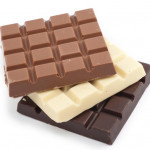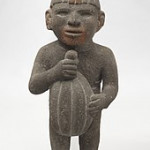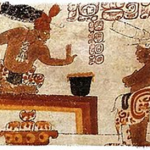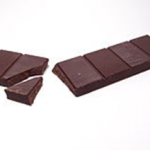By Dionysia Kloukinioti, Ariana Stigka & Andreas Papadopoulos
Chocolate is a typically sweet, usually brown, food preparation of roasted and ground cacao seeds. It is made in the form of a liquid, paste, or in a block, or used as a flavoring ingredient in other foods. The earliest evidence of use traces to the Olmecs (Mexico), with evidence of chocolate beverages dating to 1900 BC. The majority of Mesoamerican people made chocolate beverages, including the Maya and Aztecs. Indeed, the word «chocolate» is derived from the Classical Nahuatl word chocolātl.
The seeds of the cacao tree have an intense bitter taste and must be fermented to develop the flavor. After fermentation, the beans are dried, cleaned, and roasted. The shell is removed to produce cacao nibs, which are then ground to cocoa mass, unadulterated chocolate in rough form. Once the cocoa mass is liquefied by heating, it is called chocolate liquor. The liquor also may be cooled and processed into its two components: cocoa solids and cocoa butter. Baking chocolate, also called bitter chocolate, contains cocoa solids and cocoa butter in varying proportions, without any added sugar. Much of the chocolate consumed today is in the form of sweet chocolate, a combination of cocoa solids, cocoa butter or added vegetable oils, and sugar. Milk chocolate is sweet chocolate that additionally contains milk powder or condensed milk. White chocolate contains cocoa butter, sugar, and milk, but no cocoa solids.
Chocolate has become one of the most popular food types and flavors in the world, and a vast number of foodstuffs involving chocolate have been created, particularly desserts including cakes, pudding, mousse, chocolate brownies, and chocolate chip cookies. Many candies are filled with or coated with sweetened chocolate, and bars of solid chocolate and candy bars coated in chocolate are eaten as snacks. Gifts of chocolate molded into different shapes (e.g., eggs, hearts, coins) have become traditional on certain Western holidays, such as Easter, Valentine’s Day, and Hanukkah. Chocolate is also used in cold and hot beverages such as chocolate milk and hot chocolate and in some alcoholic drinks, such as creme de cacao.
Although cocoa originated in the Americas, recent years have seen African nations assuming a leading role in producing cocoa. Since the 2000s, Western Africa produces almost two-thirds of the world’s cocoa, with Ivory Coast growing almost half of that amount.
History
Chocolate has been prepared as a drink for nearly all of its history. For example, one vessel found at an Olmec archaeological site on the Gulf Coast of Veracruz, Mexico, dates chocolate’s preparation by pre-Olmec peoples as early as 1750 BC. On the Pacific coast of Chiapas, Mexico, a Mokaya archaeological site provides evidence of cacao beverages dating even earlier, to 1900 BC. The residues and the kind of vessel in which they were found indicate the initial use of cacao was not simply as a beverage, but the white pulp around the cacao beans was likely used as a source of fermentable sugars for an alcoholic drink.
An early Classic-period (460–480 AD) Mayan tomb from the site in Rio Azul had vessels with the Maya glyph for cacao on them with residue of a chocolate drink, suggests the Maya were drinking chocolate around 400 AD. Documents in Maya hieroglyphs stated chocolate was used for ceremonial purposes, in addition to everyday life. The Maya grew cacao trees in their backyards, and used the cacao seeds the trees produced to make a frothy, bitter drink.
By the 15th century, the Aztecs gained control of a large part of Mesoamerica and adopted cacao into their culture. They associated chocolate with Quetzalcoatl, who, according to one legend, was cast away by the other gods for sharing chocolate with humans, and identified its extrication from the pod with the removal of the human heart in sacrifice. In contrast to the Maya, who liked their chocolate warm, the Aztecs drank it cold, seasoning it with a broad variety of additives, including the petals of the Cymbopetalum penduliflorum tree, chile pepper, allspice, vanilla, and honey.
The Aztecs were not able to grow cacao themselves, as their home in the Mexican highlands was unsuitable for it, so chocolate was a luxury imported into the empire. Those who lived in areas ruled by the Aztecs were required to offer cacao seeds in payment of the tax they deemed «tribute». Cocoa beans were often used as currency. For example, the Aztecs used a system in which one turkey cost 100 cacao beans and one fresh avocado was worth three beans.
The Maya and Aztecs associated cacao with human sacrifice, and chocolate drinks specifically with sacrificial human blood. The Spanish royal chronicler Gonzalo Fernández de Oviedo, described a chocolate drink he had seen in Nicaragua in 1528, mixed with achiote (Bixa orellana): «because those people are fond of drinking human blood, to make this beverage seem like blood, they add a little achiote, so that it then turns red. … and part of that foam is left on the lips and around the mouth, and when it is red for having achiote, it seems a horrific thing, because it seems like blood itself.»
Types
Several types of chocolate can be distinguished. Pure, unsweetened chocolate, often called «baking chocolate», contains primarily cocoa solids and cocoa butter in varying proportions. Much of the chocolate consumed today is in the form of sweet chocolate, which combines chocolate with sugar.
Milk
Milk chocolate is sweet chocolate that also contains milk powder or condensed milk. In the UK and Ireland, milk chocolate must contain a minimum of 20% total dry cocoa solids; in the rest of the European Union, the minimum is 25%.
White
White chocolate, although similar in texture to that of milk and dark chocolate, does not contain any cocoa solids. Because of this, many countries do not consider white chocolate as chocolate at all.»White chocolate» contains cocoa butter, sugar, and milk, but no cocoa solids.
Dark
Dark chocolate is produced by adding fat and sugar to the cacao mixture. The U.S. Food and Drug Administration calls this «sweet chocolate», and requires a 15% concentration of chocolate liquor. European rules specify a minimum of 35% cocoa solids .A higher amount of cocoa solids indicates more bitterness. Semisweet chocolate is a dark chocolate with a low sugar content. Bittersweet chocolate is chocolate liquor to which some sugar (typically a third), more cocoa butter and vanilla are added.[citation needed] It has less sugar and more liquor than semisweet chocolate, but the two are interchangeable in baking. It is also known to last for two years if stored properly. As of 2017, there is no high-quality evidence that dark chocolate affects blood pressure significantly or provides other health benefits
Unsweetened
Unsweetened chocolate is pure chocolate liquor, also known as bitter or baking chocolate. It is unadulterated chocolate: the pure, ground, roasted chocolate beans impart a strong, deep chocolate flavor. It is typically used in baking or other products to which sugar and other ingredients are added. Raw chocolate, often referred to as raw cacao, is always dark and a minimum of 75% cacao. Poorly tempered or untempered chocolate may have whitish spots on the dark chocolate part, called chocolate bloom; it is an indication that sugar and/or fat has separated due to poor storage. It is not toxic and can be safely consumed.
Source
https://en.wikipedia.org/wiki/Chocolate











